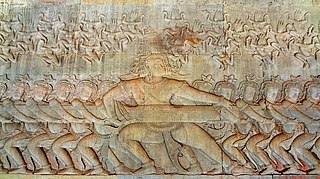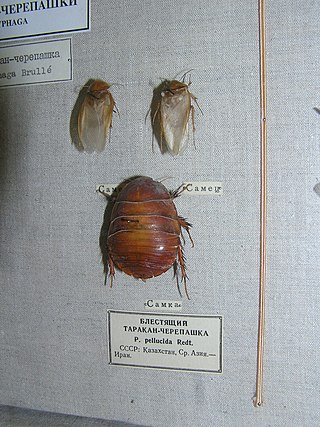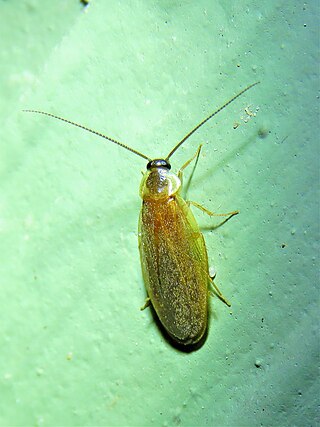
Asuras are a class of beings in Indic religions. They are described as power-seeking demons related to the more benevolent Devas in Hinduism. In its Buddhist context, the word is sometimes translated "titan", "demigod", or "antigod".

Deva means "shiny", "exalted", "heavenly being", "divine being", "anything of excellence", and is also one of the Sanskrit terms used to indicate a deity in Hinduism. Deva is a masculine term; the feminine equivalent is Devi. The word is a cognate with Latin deus ("god") and Greek Zeus.

Corydiidae, previously known as Polyphagidae, is a family of the order Blattodea (cockroaches). Many are known as sand cockroaches. The family is divided into five subfamilies, comprising some 40 genera. One prominent species is the desert cockroach, Arenivaga investigata.

The Samudra Manthana is a major episode in Hinduism that is elaborated in the Vishnu Purana, a major text of Hinduism. The Samudra Manthana explains the origin of the elixir of eternal life, amrita.

An asura in Buddhism is a demigod or titan of the Kāmadhātu. They are described as having three heads with three faces each and either four or six arms.

Compsodes is a genus of hooded cockroaches in the family Corydiidae. There are at least four described species in Compsodes.

In Hindu cosmology, the Ocean of Milk is the fifth from the centre of the seven oceans. It surrounds the continent known as Krauncha. According to Hindu scriptures, the devas and asuras worked together for a millennium to churn this ocean in order to acquire amrita, the elixir of immortal life. The episode is mentioned in the Samudra Manthana chapter of the Puranas, a body of ancient Hindu legends. The Kshira Sagara is described as the place where the deity Vishnu reclines over his serpent-mount Shesha, accompanied by his consort, Lakshmi.
Mesoptila compsodes is a moth in the family Geometridae first described by Edward Meyrick in 1891. It is found in Australia. Mesoptila compsodes is the type species of the genus Mesoptila.
Asura bipars is a moth of the family Erebidae. It is found in Queensland and New South Wales.
Asura catameces is a moth of the family Erebidae. It is found in Australia.
Asura coccinocosma is a moth of the family Erebidae. It is found in Australia.
Asura crocopepla is a moth of the family Erebidae. It is found in Australia.
Asura crocoptera is a moth of the family Erebidae. It is found in Australia.
Asura quadrilineata is a moth of the family Erebidae. It is found on Aru and in Australia.
Asura monospila is a moth of the family Erebidae. It is found in Australia.
Asura polyspila is a moth of the family Erebidae. It is found in Australia.
Asura semivitrea is a moth of the family Erebidae. It is found in Australia (Queensland).

Cyme sexualis is a moth of the subfamily Arctiinae first described by Felder in 1864. It is found on Ambon, Sulawesi, the Dampier Archipelago. and in New Guinea.
Asura zebrina is a moth of the family Erebidae first described by George Hampson in 1914. It is found in New South Wales, Australia.







